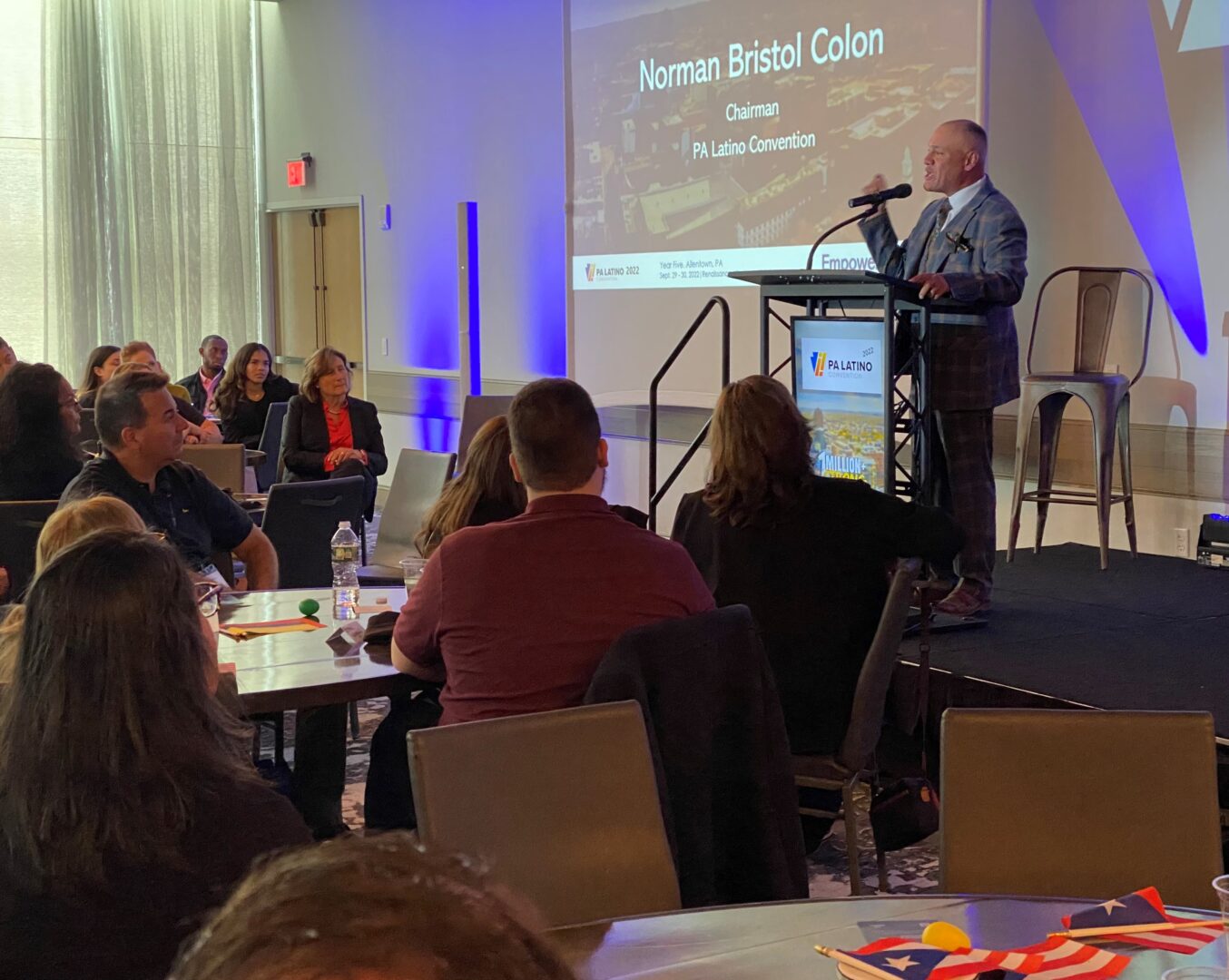
PA Latino Convention Chairman Norman Bristol Colon addresses attendees, covering topics such as equity in the workforce, voting and the economic power of Latinos.
Anthony Orozco / WITF

PA Latino Convention Chairman Norman Bristol Colon addresses attendees, covering topics such as equity in the workforce, voting and the economic power of Latinos.
Anthony Orozco / WITF

Anthony Orozco / WITF
PA Latino Convention Chairman Norman Bristol Colon addresses attendees, covering topics such as equity in the workforce, voting and the economic power of Latinos.
Listen to the story:
Pennsylvania’s Latino economy is smaller and relatively younger compared to older and more established economies in states along the Mexican border, such as Texas and California.
But a new study by the Latino Donor Collaborative, a think-tank dedicated to economic research on Latinos in the U.S., shows that the state’s Latino economy is rapidly growing. Pennsylvania ranks 6th among states for Latino economic output.
The state’s Latino gross domestic income was $36 billion in 2021, according to the study’s analysis of Census data. That represents about 4.2% of the state’s gross domestic income. It is a relatively small economy, but it has accounted for 18.4% of growth in the state’s Gross Domestic Income between 2011 and 2021.
“Essentially, what is going on there is that the state itself is growing at a rate of 1.1% per year on average, but the Latino sub-economy within that state is growing at 6.2%, so something like five and a half times faster,” said Jose Jurado, a research economist at Arizona State University and lead author of the study.
Pennsylvania’s Latino workforce represented almost 8% of the state’s entire workforce in 2021. Over a 10-year period, the state’s labor force grew by 55,000 people in total. Latinos added 161,000 people to the state’s workforce during that same time period. According to Jurado, this shows that the non-Latino labor cohort is shrinking, but the rapidly growing Latino workforce is offsetting the loss of those workers.
“They’re making up for losses among their peers, which leads to the fact that, in the aggregate, the Pennsylvania labor force is actually growing,” Jurado said.
There are 1.1 million Latinos in Pennsylvania, according to the Census. Lehigh, Berks, Lancaster and Philadelphia were the counties with the largest percentages of Hispanic or Latino residents as of 2021. The Hispanic or Latino population has grown almost 46% since 2010, while the non-Latino or Hispanic population has declined 0.2% since 2010.
Dennis Hoffman, economics professor at Arizona State University and co-researcher in the study, said the growth of the Latino economy in the state has to do, in part, with how much the population has grown in the last decade.
“It’s a very, very rapid growth that’s driven by, first and foremost, the population, and especially the youth of the population. Most of the growth in the Latino cohort is at younger ages,” Hoffman said. “You just get a greater influx of people reaching working age and maturing working age earning more income, and that clearly is driving growth in the contribution of the Latino community.”
About half of the state’s Latino population lives in a geographical area referred to as the 222 Corridor, which includes the Allentown-Bethlehem-Easton area, Reading, and metro areas in Lebanon, York, Gettysburg and Lancaster. According to data from the 2021 American Community Survey, Latino and Hispanic households in the Allentown-Bethlehem-Easton area, which has the highest population in the 222 Corridor, have a median income of $51,931, and the second largest Latino population, in Reading, has a median income of $44,329.
Jurado noted that, while Latinos have a labor rate participation 5.5% higher than their peers, there are still some disparities, specifically when it comes to education attainment. Latinos in the United States tend to have a lower share of advanced educational degrees per capita, he said.
“As time goes by, we expect some catch-up relative to their peers, and that’s going to enable members of this demographic to take on positions with a higher compensation and generally just enjoy higher social mobility,” Jurado said.
The days of journalism’s one-way street of simply producing stories for the public have long been over. Now, it’s time to find better ways to interact with you and ensure we meet your high standards of what a credible media organization should be.